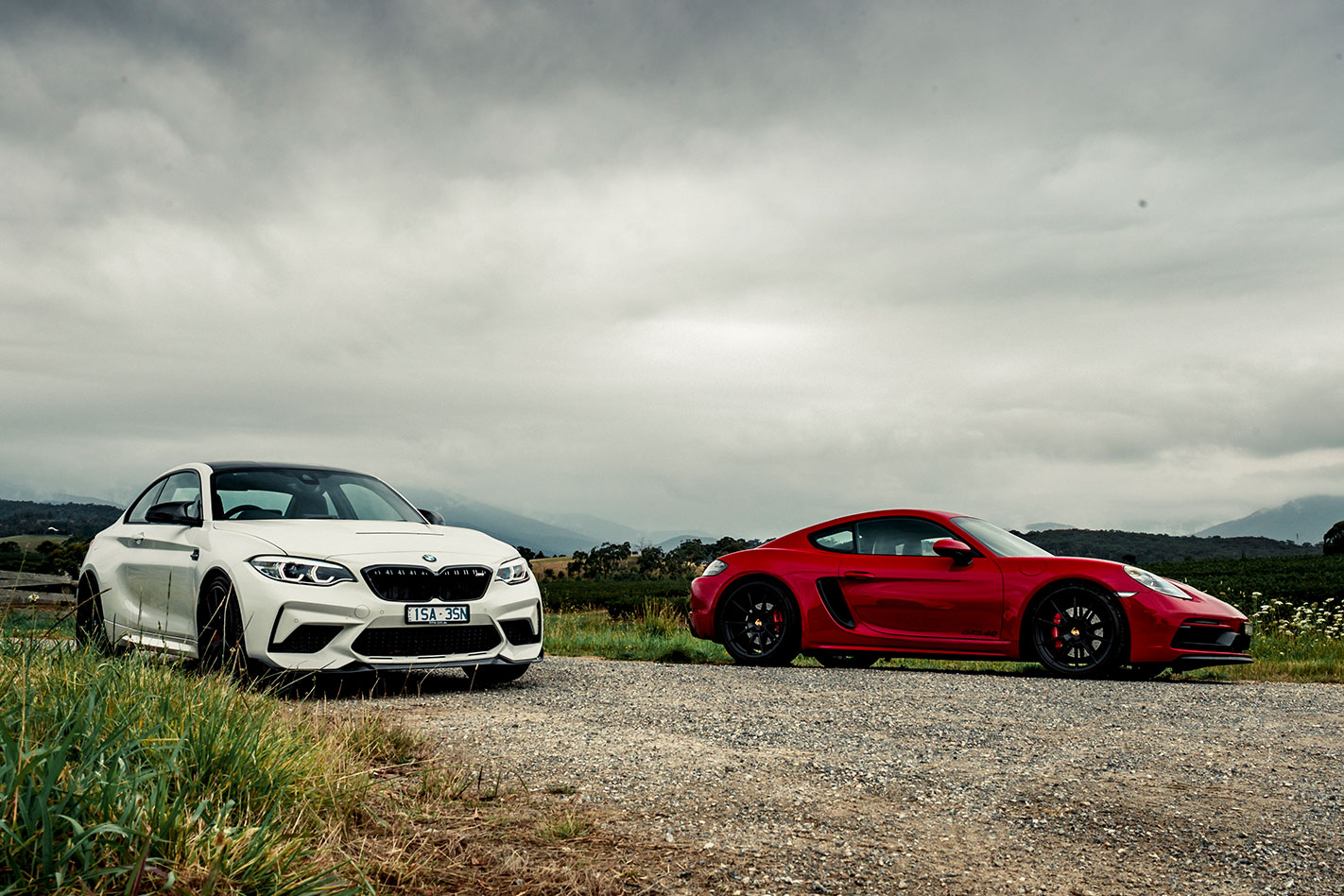It’s deadly quiet in this little pocket of Victorian wilderness near Healesville, east of Melbourne. Neon-green ferns hide at the bottom of faded eucalypts that themselves slump under a typical Victorian sky – grey, white and more shades of grey, all the colours of the German rainbow.
Pulled over on the side of Chum Creek Road in my fat-stanced BMW M2 CS, engine off, door open, I can hear the distant growing-then-subsiding bark of what could be nothing but a Porsche flat-six. (I suppose it could be a very hot naturally aspirated flat-six Subaru Liberty… or a lyrebird doing one hell of an impression.)
Former editor turned YouTube star Alex Inwood is giving the 718 Cayman GTS 4.0 plenty of curry. Without a turbocharger (or two) stimulating the engine’s mid-range, it’s a case of stretch the legs and chase the redline to extract maximum thrills.
Not that that’s anyone’s chore today. Forgetting perhaps the brilliant (yet flawed) offerings from a little British brand called Lotus, we have assembled the two best manual-equipped compact six-cylinder sports cars you can buy, boasting very different recipes despite similar ingredients.
In the white corner, BMW’s CS is the hottest iteration of the rear-drive M2 yet – and promises a proper send-off for Munich’s ageing rear-drive 1 Series platform. Channelling a little bit of CSL – we love the E46 M3, but then who doesn’t – the CS is the boss version of the M2 Competition, which itself scored a detuned example of the previous-gen M3’s S55 3.0-litre twin-turbo inline six.
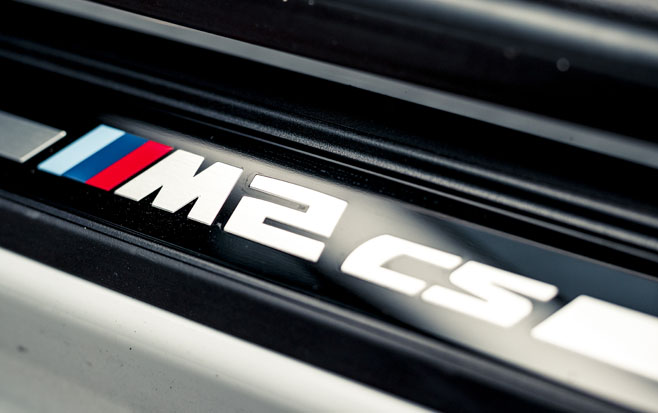
But where the Competition packed ‘just’ 302kW, the CS gets the full-fat 331kW (both CS and Comp have 550Nm). The CS comes with a six-speed manual, which we have today, or a seven-speed dual-clutch auto.
That extra power is warmly welcomed, while visually the CS is subtly but easily identifiable by its myriad styling tweaks – and extensive use of carbonfibre. Open the bespoke vented carbon bonnet and you will be astounded how light it is (ignoring the heavy-looking metal hinges at its base). On the roof there’s a wider, beefier chequer to the carbonfibre’s weave.
The front lip, rear diffuser, aero mirror caps and chunkier Gurney-style rear spoiler are all fashioned from the clear-coated black weave; while at each corner sit spindly forged 19-inch wheels available in either Jet Black or optional ($1000) matte Gold.
And behind those you can have carbon-ceramic brakes (a $15K option). Our test car wears super-soft Michelin Pilot Sport Cup 2 tyres, but Pilot Super Sports are a no-cost option.
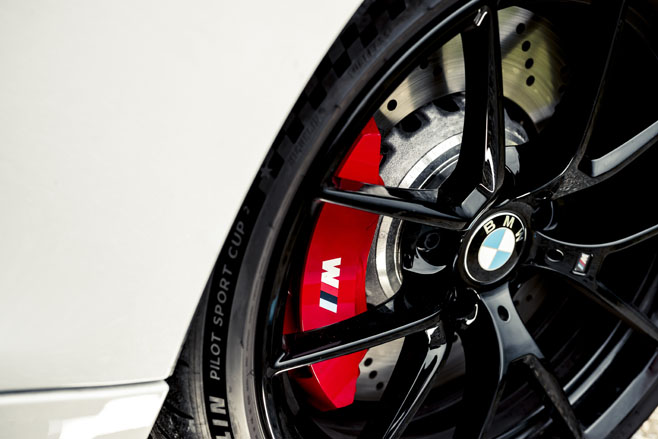
Despite all the carbonfibre bits, unless you spec the ceramic brakes, which save 25kg, the M2 CS weighs the same as the M2 Competition (1550kg). Some can be attributed to the fitment of new items such as adaptive dampers, a new oil cooler and, in the auto, a new transmission cooler.
All this extra gear comes at a price (of course), the CS swooping in at $139,900 for the manual and $147,400 for the auto.
Or $37,000 and $37,500 pricier than the M2 Competition in manual and auto respectively. But with just 86 examples of the M2 CS coming to Australia (47 DCT, 39 manual; with only a handful left of the total allocation), BMW would argue that exclusivity costs. And in this day and age there’s always the potential for appreciation with that CS badge.
Even at $150K it still seems cheap next to our six-speed manual Carmine Red Porsche 718 Cayman GTS 4.0. Despite a $172,000 MSRP, this test car packs $26,330 of options to come in at a lofty $198,330. Some of the options should definitely be standard as well, such as blind-spot monitoring ($1550) and keyless start ($1470); and if you want the full GTS Alcantara interior treatment, that will be another $9910 as well.
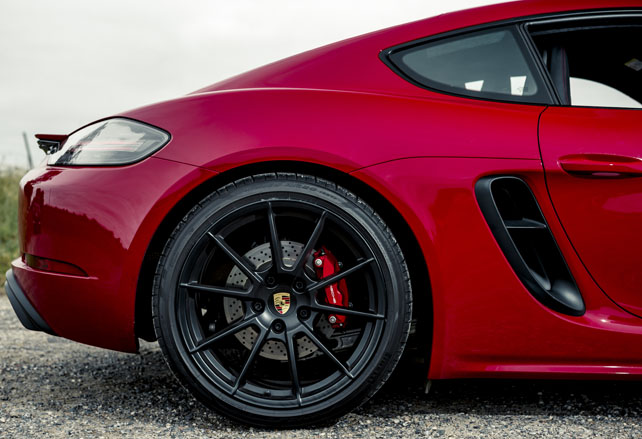
However, near $50K price difference aside, compared to the M2 – a hot-rodded 1 Series – the Cayman is a purpose-built mid-engined sports car from the ground up. Outside of the GT Division-developed GT4, the GTS is also the most aesthetic, and driver-focused Cayman of them all.
The big news with this 4.0 variant is hidden completely out of sight behind the passenger compartment. Porsche had buried the free-breathing engine for its sex-bomb GTS Boxster and Cayman in favour of fitting the fruity-sounding 2.5-litre flat-four turbo. But while this high-tech powerplant packed enough punch to turn Porsche’s junior sports cars into baby supercars, the ‘purists’ weren’t having any of it.
And so Stuttgart resurrected the atmo flat-six for what will likely be one last hurrah, in this case a big-bore 4.0-litre created, ostensibly, by dropping the turbos off the 9A2 Evo 3.0-litre in the 911 Carrera and increasing the bore and stroke. The end result is 294kW (a nice round 400 horsepower) at 7000rpm, 420Nm from 5000 to 6500rpm and a 7800rpm redline.
Elsewhere, the standard GTS treatment means 20-inch wheels front and rear, a 20mm drop in ride height, a mechanical limited-slip differential and dark highlights inside and out driving home the smoky, seductive GTS vibe. And subtly but clearly telegraphing its specialness to others, to the point that on our test the Porsche turned way more heads and attracted far more stares than its white Bavarian foe.
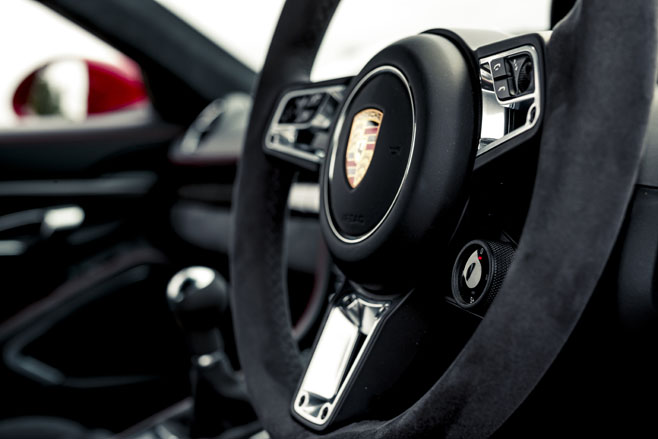
The same vibe continues in the cabin, where dark trim contrasts against red stitching and plenty of Alcantara. In classic sports car style, the Cayman positions your hips low and snug in the seats. You sit very much ‘in’ the Cayman GTS, differing from the BMW’s airier, more open cabin.
If you also own a 992, Cayenne or Panamera, you will think the 718’s interior overall is looking a bit last-generation, and it is, but it remains charmingly simple, quality-feeling, well appointed and comfortable. It feels its price – just.
You can’t quite say the same about the BMW. It tries hard, with generous swathes of soft Alcantara trim, inserts of carbonfibre and sumptuous Merino leather, but this just creates even stronger a contrast to the budget-based materials you would have found in the cheapest of 1 Series.
On the upside, unlike other halo M models, BMW does treat M2 CS owners to regular door cards with generous bins and actual interior doorhandles (rather than straps). The custom CS carbonfibre centre console looks cool and retains two USB outlets but means you lose a centre storage compartment. No biggie.
The BMW’s quirks continue as you start it up and get underway. Its loud, buzzy idle sounds like… well, a large water pump. Compared to the low and wide Porsche, it feels humorously tall, narrow and upright.
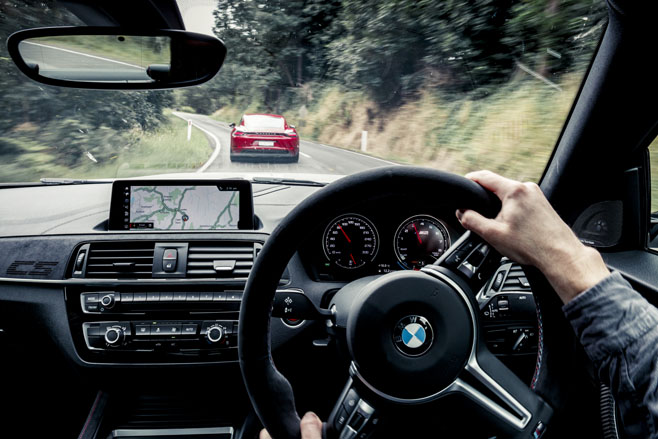
The manual gear-action probably won’t be remembered as one of the greatest, either, with its excessively sprung, long-throw, slightly notchy and imprecise action, like stirring a bucket of tightly packed rubber bushes. For many, though, even an average manual trumps a great automatic.
Despite its adaptive dampers, the CS remains a very focused machine with plenty of tyre rumble. Owing as well to all its solid-mounted suspension joints, cat’s eyes thud firmly through the car’s entire superstructure.
There is a muted suppleness to the ride we don’t remember of the M2 Competition, but the adaptive dampers’ effect is hardly transformative, the softness not changing much between its Comfort, Sport and Sport Plus modes. Over a long distance, the M2 CS offers the bare minimum comfort, possibly slightly less. It would be better on more regular performance tyres.
Despite not being the GT4, and on less-aggressive Pirelli P-Zero tyres, the same is true of the GTS 4.0. With plenty of tyre noise, it also offers minimal comfort, though slightly more than the BMW. You wouldn’t want the dampers any firmer or with any less stroke. The Porsche has its own useability quirks, too.
The fairly soft plastic front chin spoiler is about as low as that on a GT2 or GT3 RS, but the 4.0 has no front lifting system, requiring extra care around driveways and speed humps. The electric park brake isn’t automatic, so if you park on a hill not in gear and forget to apply it, well, get ready to bolt… On the freeway on part throttle, the GTS can also be heard, and ever-so-slightly felt, deactivating from six to three cylinders to save fuel, clearing your green conscious at least a small amount.
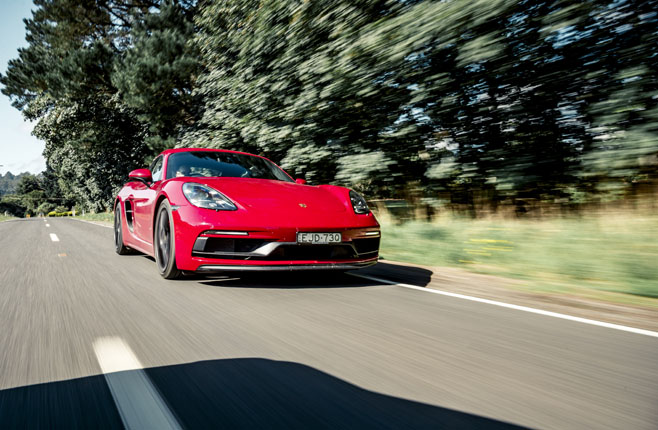
There is also a well-judged weightiness to all the Porsche’s controls – be they the meaty clutch, the precise shifter, the syrupy steering – that just makes it satisfying to drive at all times. It’s an easy, pleasant and forgiving manual to use everyday as well.
Entirely redeeming the Porsche for any comfort criticisms is that engine. And then some. It’s a masterpiece of tractability at any rpm, in any situation. Around town, you can drive off from second; you can shift from second to fourth, fourth to six, and it just pulls, no complaints.
Flex the throttle just a little bit and there’s the sensation of a big-capacity atmo engine at your disposal. While it can’t match anything with turbos for mid-range oomph, in isolation the GTS’s 4.0-litre has more than enough torque, pulling cleanly and keenly from anywhere in the revs.
A torque graph buried in one of the menus reveals that this is an engine built for old-school, big-bore, long-stroke torque. And it’s this wave of crisp muscularity that hurls you into a frenzied powerband on the way to redline.
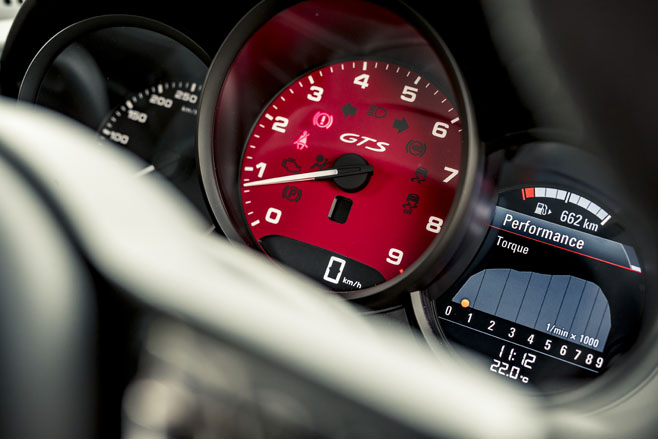
You will absolutely be wanting to chase every last rev, as the entire cabin floods with a clear, melodic, racy flat-six noise that scratches itches you didn’t know you had. And, owing to its dual-mass flywheel, this engine is deliciously free-revving. One of the greatest engines ever? It’s hard to think of reasons why not.
The M2’s twin-turbo straight-six couldn’t be more different in character. Where new turbocharged engines like AMG’s 2.0-litre M139 are now achieving almost zero lag, BMW’s S55 water-to-air intercooled unit remains wickedly old-school in its power delivery.
Flatten the throttle at 1500rpm and you’re pulling a pin out of two grenades, set to go off at 5000-6000rpm. The S55, with its acquired-taste, technical-sounding exhaust note, mixes sudden incredible mid-range turbo torque and a punchy top-end to its 7600rpm redline. But absolutely this is an engine whose torque you surf, rather than whose redline you chase.
Where the Porsche feels to have power and traction (from its rear 265-section Pirellis) in equilibrium, the BMW is constantly surprising its rear 265-section Michelin Pilot Sport Cup 2s, especially if they’re cold, which will tend to always be the case in the urban jungle.
With our home dragstrip Heathcote Park unavailable, we didn’t get to performance-test our two combatants this time around. Porsche claims 0-100km/h in 4.5sec and a top speed of 293km/h; BMW, 4.2sec for the manual CS on to a limited 280km/h.
In a clutch-dropping, away-from-the-lights contest, the mid-engined Porsche would be certain to show up traction woes on the part of the BMW, but we suspect it would be a different story for 80-120km/h rolling punch.
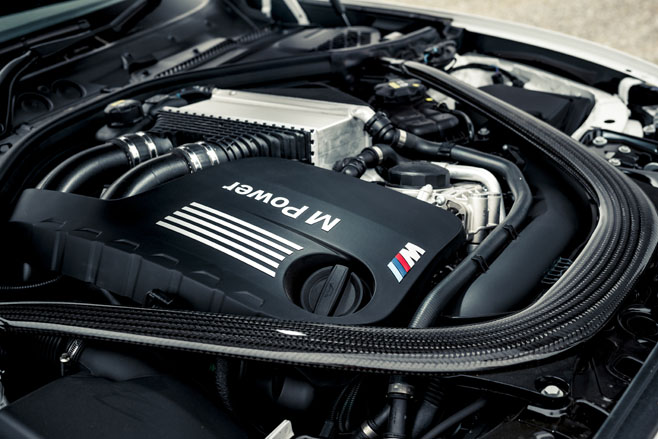
Throw some corners into the mix and it’s down to the road surface as to who will edge away from who. In the damp conditions early in our test, the Pirelli-shod Porsche eked slowly away from the BMW as it struggled to turn its sticky Michelins ‘on’.
But as the day dried up the BMW became the car to catch, almost exclusively owing to its tyres, the Cup 2s offering phenomenal tenacity and confidence-inspiring feedback and feel. In dry conditions these are truly mind-blowing performance tyres. In fact, they dominate the CS handling experience on a dry road. All you can think about is the grip.
But there are other CS virtues to enjoy. The brakes are incredible, and there is something special about the supple, expensive-feeling damping at high speed. Despite slightly numb steering no matter which of the three modes you’re in, the solid-mounted suspension grants beautiful rear-axle feel, as if the rear wheels are bolted to your hips.
Combine this with all that power, an accuracy and predictability about the throttle, and an especially lenient ‘M Driver’s Mode’ ESC, and in the CS you have a devil at your shoulder, egging you into easy and hilarious second-gear tail-wags out of every corner. If that’s what you like.

The Porsche couldn’t be more different. While the BMW is all about maximising corner entry speeds and managing traction on exit, the beautifully cohesive Cayman GTS is about flowing from corner to corner and trying to avoid pushing those skinny 235-section front tyres into understeer.
Power oversteer, which requires serious coaxing, feels a most uncouth request of the Cayman GTS. This is a car that carves up the road in harmony, sitting a lot lower and more flat than the BMW, its sublime controls feeling like cheese to the BMW’s chalk. It is very much the more puristic experience.
Picking an objective winner of these two is fairly easy. One car is a scalpel, the other a hammer. One car feels like a cohesive performance package, the other a ‘greatest hits’ of a performance parts bin (and what a performance parts bin). They’re both exceptionally fast cars in very different ways.
The BMW brutalises the road with fat wads of torque and super-sticky tyres. It’s more exciting. You have to manhandle it a bit, hammer into the corner, brake hard, get it turned, then hammer back out again.
The Porsche muscles through long gears to the point where you get a rude shock at how fast you’re going. It’s a seriously, deceptively fast car. But it also asks that you are more delicate and deft with your inputs.
There is no subjective winner, though. The Porsche is a car you master; the BMW a car you tame. It’s difficult to think of ways to improve the Porsche, but it’s easy to think of ways to improve the cheeky, rapscallion BMW. Many will find that endearing. I know I do.
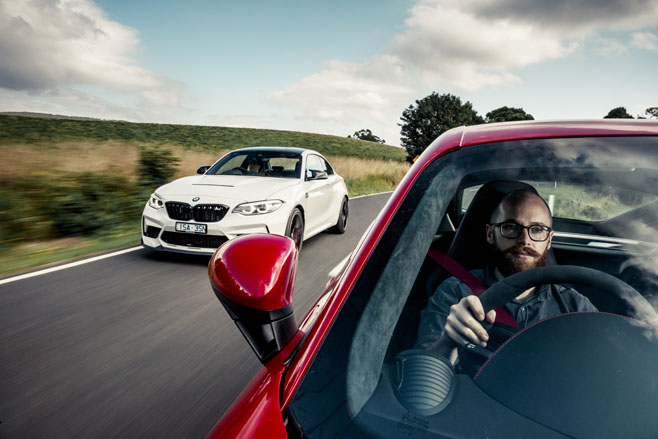
Specifications
u00a0 | Porsche Cayman GTS 4.0 | BMW M2 CS |
u00a0 | $172,000/Tested $198,330 | $139,900/ no options |
u00a0 | Drivetrain | u00a0 |
Engine | flat-6cyl, dohc 24v | inline-6cyl, dohc, 24v, twin-turbo |
Layout | mid engine (north-south) RWD | front engine (north-south) RWD |
Capacity | 3995cc | 2979cc |
u00a0Power | 294kW @ 7000rpm | 331kW @ 6250rpm |
Torque | 420Nm @ 5000-6500rpm | 550Nm @ 2350-5000rpm |
Gearbox | 6-speed manual | 6-speed manual |
u00a0 | Chassis | u00a0 |
Body | aluminium/steel, 2 doors, 2 seats | steel/ carbonfibre, 2 doors, 4 seats |
L/W/H/Wu2013B | 4405/1801/1276/2475mm | 4461/1871/1414/2693mm |
Track (F/R) | 1527/1532mm | 1579/1601mm |
Weight | 1405kg | 1550kg |
Boot | 420L | 390L |
Fuel/tank | petrol/64 litres | petrol/52 litres |
Economy | 11.0L/100km (claimed, combined) | 10.3L/100km (claimed, combined) |
Suspension | Front: struts, adaptive dampers, anti-roll bar. Rear: multi-links, adaptive dampers, coil springs, anti-roll bar | Front: struts, adaptive dampers, anti-roll bar. Rear: multi-links, adaptive dampers, coil springs, anti-roll bar |
Steering | electric rack-and-pinion | electric rack-and-pinion |
Front brakes | ventilated discs (350mm) | ventilated discs (400mm) |
Rear brakes | ventilated discs (330mm) | ventilated discs (380mm) |
Tyres | Pirelli P Zero | Michelin Pilot Sport Cup 2 |
Tyre size | 235/35 ZR20 (f) 265/35 ZR20 (r) | 245/35 ZR19 (f) 265/35 ZR19 (r) |
u00a0 | Safety | u00a0 |
ANCAP rating | Not tested | Not tested |
Verdict | 8.0/10 | 7.5/10 |

